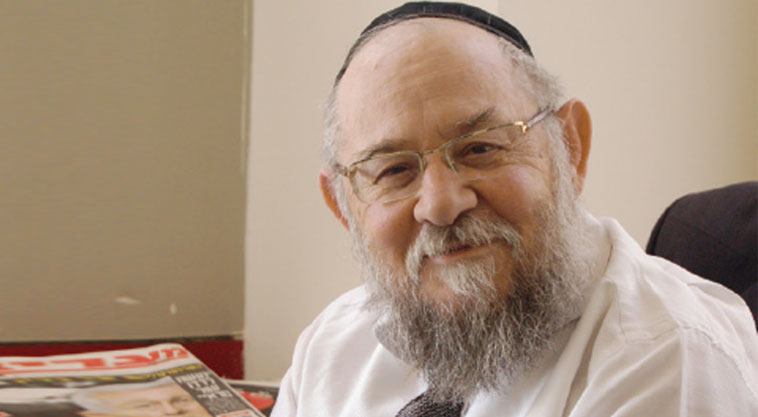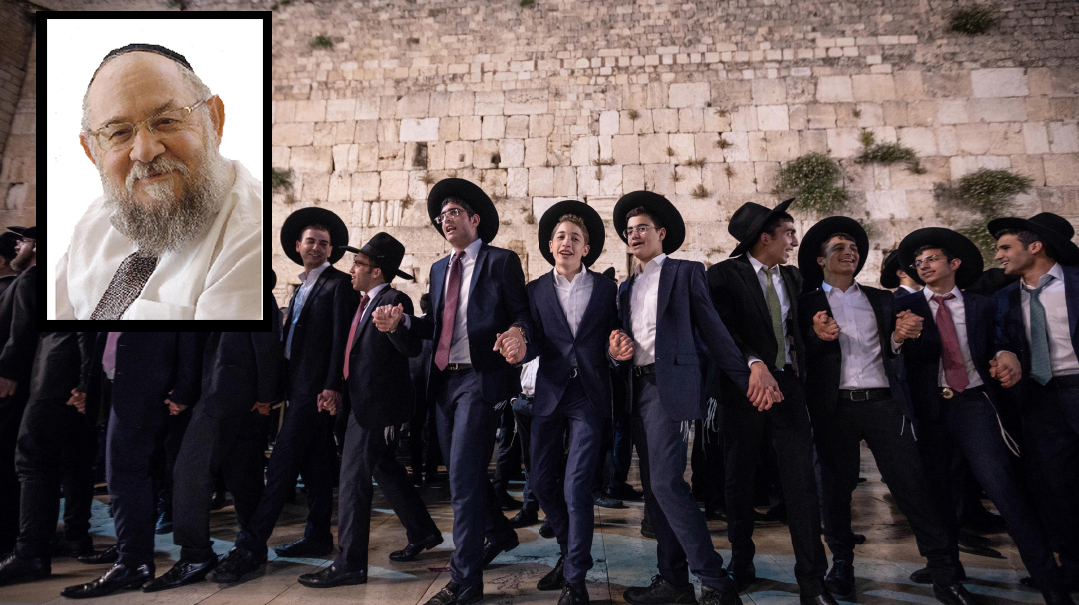No Argument


In secular circles Shammai’s name has become synonymous with zealotry narrow-mindedness and spiritual closure. But Shammai said “Receive every man with a pleasant countenance” — so how does that fit?
Israeli president Mr. Reuven Rivlin is a very pleasant likable man. And although he hails from the famed Yerushalmi Rivlin family who were students of the Vilna Gaon he is a product of secular Israeli culture and education — a system self-servingly injected with distorted Jewish concepts.
So it’s no wonder that when the president spoke at a rally last week he invoked an old cliché that depicts the great Tanna Shammai as hard-hearted and unbending whereas his colleague Hillel is seen as the epitome of sympathy and understanding. And so often when this false and hackneyed comparison is brought up by secular Israelis it’s the Torah leaders of the chareidi world who are accused of taking the harsh unrelenting path of Shammai.
Some years back I had an interaction with a Reform clergyman who praised himself as “a follower of Beis Hillel.” To large segments of the Jewish People in Israel and around the world Shammai’s name is synonymous with zealotry narrow-mindedness spiritual closure and dogged conservatism. He’s pictured as cranky irritable and unapproachable. Shammai has not had the benefit of a good public relations campaign.
Yet when we return to the first chapter of Pirkei Avos this Shabbos we will find it was Shammai who said “Make your Torah learning a fixture say little and do much and receive every man with a pleasant countenance.”
Surprising words from the alleged archetype of irritability!
And these aren’t merely words. Pirkei Avos is not a random collection of wise epigrams or pithy witticisms. Rather every gem in these mishnayos encapsulates the essence of the speaker’s approach to life. And so we can safely assume that Shammai was in fact in the habit of giving a warm loving reception to anyone who approached him. His firm insistence on preserving the purity of halachah has been distorted by the Maskilim and their inheritors who drew the false picture of a demanding cantankerous zealot.
Hillel on the other hand is seen by these folks as the antithesis of Shammai: To them he represents sweetness and light all that is charitable and open-hearted. He as opposed to Shammai is the enlightened one the one who makes life easier by saving us from a burdensome religion with his supposedly liberal interpretations of the Torah.
Those who like to say of themselves “I’m from Beis Hillel ” mean to say “I’m open-minded; I don’t subscribe to the hairsplitting approach of those strict rabbis.”
Hillel would have been appalled had he heard such notions attributed to him. Indeed from the little that we know of this holy Tanna we can safely say that to be hailed as a reformer who would reinvent the Torah to suit changing times would horrify him.
Hillel sought something entirely different: to rehabilitate the nation so that all the people could walk the path of Torah as they should. Never did he show any tendency to be lenient about fulfillment of mitzvos in order to accommodate those who claimed it was too difficult.
AND WHAT ABOUT HILLEL’S TAKANOS? Some try to hold up the takanah of prozbul for example as proof that Hillel made “improvements” to the Torah in order to make Jewish life easier. But in fact it is this very takanah that serves as proof of Hillel’s absolute adherence to the exactitude of Hashem’s Torah.
The Gemara says: “This was one of the takanos instituted by Hillel the Elder when he saw that the people were refusing to lend money to one another thereby transgressing what is written in the Torah: ‘Beware lest there be in your heart an unbridled thought saying “The seventh year the year of release has approached ” and you will begrudge your needy brother and not give him… and it will be a sin in you.’ And this is the basic content of the prozbul: I hand over any debt owed to me by Ploni to you the dayanim so that [by the authority of beis din] I may collect it when I wish” (Gittin 36).
Hillel noticed that as the shemittah year approached fewer people were giving loans for fear that that the debtor might delay repayment until he could take advantage of the Torah’s cancellation of debts at the end of the shemittah year and then the lender would never get his money back. But those who held back from lending for this reason were transgressing the Torah’s explicit warning not to allow shemittah to deter them from helping their needy brethren. Hillel addressed this problem by creating the takanah of prozbul by which debts could be transferred to a beis din.
It should be noted that the concept of handing over debts to a beis din so that shemittah should not cancel them was not Hillel’s invention; that had already been established as halachah before Hillel’s time. What Hillel did was to broaden awareness and application of the existing halachah so that all the people could act in accordance with it and heed the Torah’s admonition not to be deterred from lending to the needy. Without going into the intricacies of the halachic process suffice to say that through his takanah Hillel ensured that the Jewish People whom he so loved and for whom he had such prodigious patience would keep the Torah’s commandments and not be judged as wicked.
And this was the purpose behind all of Hillel’s takanos. Hillel and Shammai the nasi and av beis din of the Sanhedrin respectively were of one mind when it came to the essential goal of their rulings. If we examine the few machlokos that arose in all the years that they worked in tandem we find that those rulings were not about core issues of belief or halachah. These two great personalities identified with the same principles and by these principles they led the people.
Yet despite their identical alignment there was a difference — of emphasis and of form but not of content and certainly not of essence. Shammai personified “yikov hadin es hahar” — uncompromising truth. Hillel too promoted uncompromising truth but in a different form. The difference stands out in the three stories about the non-Jews who came to Shammai and to Hillel seeking giyur.
The first of these conversion candidates informed Shammai at the outset that he was not willing to accept the Oral Torah. “Shammai scolded him and put him out [of the beis din] with a reprimand.” Hillel on the other hand convinced him with gentle logic of the truth of Torah shebe’al peh. The second of these gentiles asked Shammai to reward him for his desire to convert. He wanted to be appointed Kohein Gadol and serve in the Beis Hamikdash. This man too was scolded and summarily dismissed. Hillel on the other hand encouraged him to learn Torah and in the process the conversion candidate came to understand for himself that kehunah is only for those born into it.
The third story is the famous tale of the gentile who asked Shammai to teach him the whole Torah while standing on one foot. Shammai sent the man away whereas Hillel taught him “That which is hateful to you do not do to your fellowman; now go and learn the rest!” The would-be convert understood the lesson: In order to fulfill this broad principle one must diligently study the entire Torah while standing firmly with both feet on the solid ground of reality.
We can be certain that Shammai received all of these applicants for conversion in a welcoming manner. That was his own rule of conduct — “Always welcome every man with a friendly face.” Yet his zeal for absolute truth did not allow him the option of responding in any other way. Hillel too insisted on the truth but preferred to arrive at it in a gentle and indirect manner.
Their most famous dispute on lighting the Chanukah lights — starting with one and ascending each day (Hillel) or starting with eight and descending each day that passes (Shammai) — is really a question of where to begin when a person desires spiritual growth: Do you shoot for the whole package at once or do you take one step at a time? Do you emphasize potential or current physical reality? Chazal tell us that although today we adhere to the rulings of Beis Hillel in the future our lives of maximized potential will adhere to the rulings of Beis Shammai.
If we’re really interested in truth we’d best refrain from holding up false images of the great enduring teachers of our nation. (Originally featured in Mishpacha Issue 668)
Oops! We could not locate your form.




